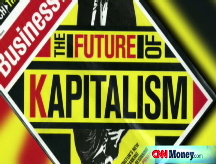Credit markets get breathing room
The cost of borrowing continues to decline, but challenges remain for the global economy.
NEW YORK (CNNMoney.com) -- Credit conditions continued to improve Wednesday with bank-to-bank lending rates easing further but global economic uncertainty tempered enthusiasm.
"Banks are lending," said Kim Rupert, a fixed income analyst at Action Economics. "The credit market is opening up a bit, but we've still got a long way to go."
The credit markets have been plagued by a severe lack of confidence amid the turbulence in the global financial system. While the cost of borrowing has come down, suggesting that banks are growing more willing to lend, the crisis is far from over.
Governments around the globe have taken aggressive steps to help restore confidence in the financial system. But the outlook for the broader economy remains dark.
"The question is now: Will this be a long and deep recession or a more moderate one?" Rupert said.
Signs of a thaw: The London-Interbank Offered Rate (Libor), a key lending rate, continued its downward march with the overnight rate falling to 1.12% from 1.28% Tuesday, according to Bloomberg.com. That's a far cry from the 6.88% record high it spiked to earlier this month after the U.S. bailout package was signed into law.
Libor is a daily average of what 16 different banks charge other banks to lend money in London and is used to calculate adjustable rate mortgages. The higher the rate, the more difficult it can be for homeowners to meet their payments.
Longer-term lending rates also improved but remain steep. The 3-month Libor fell to 3.54% from 3.83% Monday, according to Bloomberg.com. Last week, the 3-month rate surged to 4.82% - the highest since mid-December 2007. And just a month ago, the rate was below 3%.
Meanwhile, the Libor-OIS spread, which measures how much cash is available for lending between banks, narrowed slightly to 1.04 percentage points from 1.05 Tuesday. A narrower spread means there is more cash is available for lending.
Still, the concern that many investors feel about the health of the economy is reflected in a key measure of the market's appetite for risk.
The "TED spread" widened to 2.55 percentage points from 2.61 points Tuesday. This spread measures the difference between the 3-month Libor and the 3-month Treasury bill. A wider spread means the market is more wary of risky investments.
Treasurys: U.S. government debt prices rose Wednesday as stocks extended their decline for yet another day.
The benchmark 10-year note rose 26/32 to 103 18/32 and its yield fell to 3.6% from 3.71% on Tuesday. Bond prices and yields move in opposite directions.
The 30-year bond rose 2 20/32 to 107 16/32 and yielded 4.06%, down from 4.19%. And the 2-year note gained 6/32 to 100 29/32 with a yield of 1.51%.
Treasury bond prices often climb when stock prices fall as investors seek the perceived safety of government debt.
"It's the flight to quality," said William Larkin, portfolio manager at Cabot Money Management in Boston.
The yield on the 3-month note fell to 1.006% from 1.1%. A lower yield on the 3-month bond suggests that investors are becoming more cautious.
Fed's latest tool: The Federal Reserve said Wednesday it will raise the interest rate it pays commercial banks on reserve holdings, giving the central bank yet another tool to combat the credit crisis.
The change, which goes into effect Thursday, will raise the rate to 1.15% from 0.75%. The rate is calculated by subtracting a set number of basis points from the Fed's target rate, which stands at 1.5%. In this case, it will subtract 35 basis points. Previously it subtracted 75 basis points.
The move gives banks more incentive to store excess cash at the Fed and will give central bankers more control over the fed funds rate, its key overnight lending rate target.
"It gives policy makers more room to maneuver if they want to cut rates in the future," said Kim Rupert, fixed income analyst at Action Economics.
The Fed announces its fed funds rate target after every meeting of its Federal Open Market Committee. But in fact the rate is movable: The central bank must buy and sell Treasurys to keep it close to the target.
"The Fed has been flooding system with reserves. And as a result, the funds rate was well below target rate," Rupert said. "That has caused problems for monetary policy makers."
The Fed has struggled to keep the funds rate close to its target as it takes on troubled financial assets as collateral - rather than holding Treasurys.
By agreeing to pay interest closer to the fed funds, there is little chance that the fed funds rate will fall below the target because banks will have no incentive to loan money for less.
The Fed will hold its next two-day policy meeting Oct. 28-29. Expectations are high that another rate cut is in the cards.
Investors are also increasingly hoping for another coordinated cut.
Bank of England Governor Mervyn King warned Tuesday that the British economy is now probably in recession and hinted at a possible interest rate cut.
"It now seems likely that the U.K. economy is entering a recession," King said in a speech to British executives.
Late Tuesday, Secretary Henry Paulson said it is critical that nations work together to solve the crisis. And early Wednesday, President Bush said he would host world leaders on Nov. 15 for a summit to confront the world financial crisis. He will invite the leaders of the G20 group of countries "to discuss the financial markets and the global economy," White House spokeswoman Dana Perino said. ![]()




